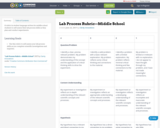
A rubric in student language written for middle school students to self-assess their lab process skills as they plan and conduct experiments.
- Subject:
- Applied Science
- Life Science
- Physical Science
- Material Type:
- Assessment
- Date Added:
- 06/22/2017

A rubric in student language written for middle school students to self-assess their lab process skills as they plan and conduct experiments.
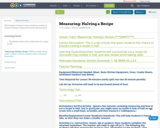
This template is meant to be an activity for students to practice halving a recipe and to review lab procedures.
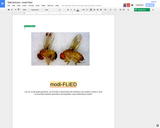
Students will breed fruit flies through several generations and record their data using mathematical models in order to demonstrate the inheritance of trait variations.
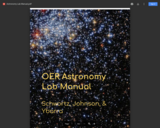
Open source astronomy lab manual, including 21 labs, 6 instructor manuals, a sample lab report, and a sample lab grading rubric. Intended for 100-level non-majors astronomy lab courses, but can also be used with modifications at other levels.
Google Docs: https://bit.ly/Astronomy-Lab-Manual
PDF: https://bit.ly/Astronomy-Lab-Manual-PDF
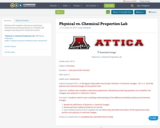
Students will complete a laboratory experiment, followed by answering questions as to whether the changes were physical or chemical in nature.
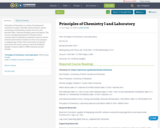
Principles of Chemistry is a study of fundamental chemical concepts: scientific measurements, matter and energy, stoichiometry, atomic structure, the periodic table, chemical bonding, gases and liquids. The course is designed primarily for students with a concentration in biological or physical sciences and for students interested in transfer to a four-year program in engineering. A three-hour lab session is required each week. All course content created by Kimberly Stieglitz. Content added to OER Commons by Julia Greider.

Size, Scales, and Specialization was developed as part of an effort by the Quantitative Biology at Community Colleges group to provide materials that incorporate mathematical concepts into biology courses. The activity uses published estimates of cell type numbers in the human body along with size, density and weight as a lens to have students calculate ratios, explore exponents, and better understand how the various cell types contribute to an average human's total weight and size. The activity is applicable for majors and non-majors biology courses, and maps to Chapter 4 of the OpenStax Biology 2e textbook. This activity could also be used in a mathematics course as a biologically relevant example.
The activity contains a pre-assessment to gauge student understanding of the material and provides an opportunity for students to predict the number of various cell types, as well as the mass of various cell types, in the human body. This prediction activity is followed with a guided approach to calculating these values. After guiding the students in this activity, students will then have a chance to practice the activity on a new set of cell data provided.
After completing this module students should be able to:
- Compare and contrast the structure and function of different cell types.
-- List the largest and the smallest cells in the body based on number.
-- List the largest and the smallest cells in the body based on mass.
- Describe the advantages of specialization in eukaryotic cells.
-- Give examples of how specialization in cell types affects cell size (volume) and shape.
- Perform measurements and conversions using the metric system.
-- Measure the scale of cell size variation in the human body
-- Calculate the relative proportions of cell types in the human body by mass and frequency

Hundreds of scientific articles. Written for middle and high school students. Approved by scientists. Free.

Lab worksheet with the purpose of calculating the speed of sound in the classroom. To be used after introduction to standing waves and harmonics in a pipe that is closed at one end.
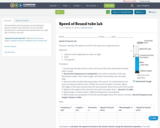
Lab worksheet with the purpose of calculating the speed of sound in the classroom. To be used after introduction to standing waves and harmonics in a pipe that is closed at one end.

Over the course of the unit, students will explore a variety of texts and grow in their knowledge of superbugs
and and their evolution over time. They will use informational text, video, lab activities and infographics to
support their inquiry and research.

This lesson is designed to familiarize new students with an angle grinder. Students will learn the key PPE, parts, and then demonstrate how to use it.
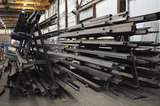
This lesson is designed to familiarize new students with a piece of equipment they will use weekly if not daily in the welding lab. Students will learn the key parts and features of a band saw and finally demonstrate how to use it.
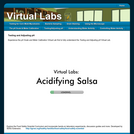
Adding acidic ingredients is an important way to protect foods from dangerous toxins produced by organisms like C. botulinum, a microbe that is common and harmless in the environment but deadly when sealed with food in a jar. In the lab, testing the pH of a substance (how acidic or basic it is) provides important information for ensuring food safety. This module introduces users to proper sampling techniques when testing pH and explains how adjusting a food’s acidity can keep it safe from C. bot. Virtual Labs – Acidifying Salsa familiarizes the user with food science lab equipment and teaches standard techniques for sampling. The interactive animation guides the user through theory and practice of adjusting pH, so they will have familiarity with the equipment and procedures when encountered in a real lab.
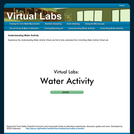
Moist foods – like fresh fruit or raw meat – often have high water activity and spoil quickly. But some foods that seem moist – like jam or pepperoni – don’t spoil as quickly. Why is this? All living things need water to survive. Enzymes and chemical reactions also require water. If water activity is less than 0.6, almost all microbes, including bacteria, molds, and yeasts, stop growing. This means that food can be preserved against spoilage by lowering its water activity – whether by evaporating water away or binding it up. Virtual Labs – Understanding Water Activity familiarizes the user with food science lab equipment and standard techniques for measuring water activity. The interactive animation guides the user through both theory and practice, preparing them for experiences in a real lab. Complete this lab first, then follow up with Virtual Labs – Controlling Water Activity.
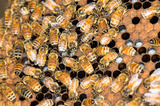
Learn how important the honey bee's body structure is to survival in the hive.What if there were no bees? How would it affect our grassland animals? How would it affect humans? This learning module offers insight into the problems that countless animals and plants face with the potential loss of the bees. Discover just how important this tiny species is to the food web of this ecosystem.This module could be incorporated into a larger environmental science module.This lesson includes learning objectives, material and resource lists, background information, activities, videos, writing assignments, a game, assessments, and support documents. See the Educator's Guide for more video links and recommended readings. Remix of: 1.Create a Bee Hummer, Science Snacks Exploratorium 2. What If There Were No Bees? A Bee Cause Project 3. Hive Alive! Bee Bodies
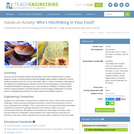
How can you tell if harmful bacteria are growing in your food? Students learn to culture bacteria in order to examine ground meat and bagged salad samples, looking for common foodborne bacteria such as E. coli or salmonella. After 2-7 days of incubation, they observe and identify the resulting bacteria. Based on their first-hand experiences conducting this conventional biological culturing process, they consider its suitability in meeting society's need for ongoing detection of harmful bacteria in its food supply, leading them to see the need for bioengineering inventions for rapid response bio-detection systems.

Wind Turbine project to build simple rotors, and test for Gravitaitonal Potential Energy.